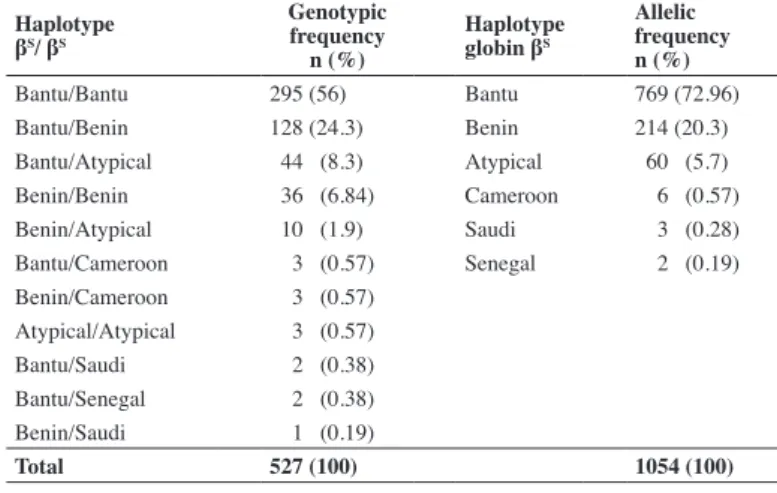Letter to Editor
71 Rev Bras Hematol Hemoter. 2013;35(1):71-2
Beta-S globin haplotypes in patients with sickle cell anemia: one approach to understand
the diversity in Brazil
Jéssika Viviani Okumura1 Clarisse Lopes de Castro Lobo2 Claudia Regina Bonini-Domingos1
1Universidade Estadual Paulista “Júlio de Mesquita Filho” – UNESP, São José do Rio Preto, SP, Brazil
2Instituto Estadual de Hematologia Arthur de Siqueira Cavalcanti – HEMORIO, Rio de Janeiro, RJ, Brazil
Conlict-of-interest disclosure:
The authors declare no competing inancial interest
Submitted: 10/24/2012 Accepted: 12/11/2012
Corresponding author:
Jéssika Viviani Okumura
Universidade Estadual Paulista “Júlio de Mesquita Filho” (UNESP)- Instituto de Biociencias, Letras e Ciências Exatas Laboratório de Hemoglobinopatias e Genética das Doenças Hematológicas
Rua Cristóvão Colombo, 2265, Jardim Nazareth 15054000 São José do Rio Preto, SP, Brazil jessika_okumura@hotmail.com
www.rbhh.org or www.scielo.br/rbhh
DOI: 10.5581/1516-8484.20130019
Sickle cell anemia (SCA) is deined as a monogenic disease that characterizes the homozygous state of hemoglobin S (Hb S). Hemoglobin S polymerizes under adverse conditions such as deoxygenation, acidosis or dehydration. Its polymers deform erythrocytes and lead to a diverse and complex pathophysiology(1,2). Beta-S globin haplotypes (βS haplotypes) are important in the comprehension of the clinical diversity of SCA patients. Five haplotypes have been associated with different ethnic groups. They are identiied at speciic restriction sites and named according to their region of origin and prevalence: Bantu, Benin, Senegal, Arabic-Indian (Saudi) and Cameroon(3). This study aimed to assess the frequencies of βS haplotypes in patients with SCA from Rio de Janeiro State, Brazil. We analyzed DNA samples from 790 patients with sickle cell disease (SCD) and classiied them according to their haplotypes through an analysis of six polymorphic sites reported by Sutton et al.(4). According to these authors, haplotypes that do not exhibit known digestion patterns should be classiied as atypical. The polymorphic sites were evaluated by polymerase chain reaction (PCR) followed by restriction fragment length polymorphism (RFLP)(4,5). Of the 790 patients, 527 had SCA with the following frequencies of genotyped βS haplotypes: 295 (56.0%) Bantu/Bantu; 128 (24.3%) Bantu/Benin; 44 (8.3%) Bantu/Atypical; 36 (6.84%) Benin/Benin; 10 (1.9%) Benin/Atypical; three (0.57%) Bantu/ Cameroon; three (0.57%) Benin/Cameroon; three (0.57%) Atypical/Atypical; two (0.38%) Bantu/Saudi; two (0.38%) Bantu/Senegal and one (0.19%) Benin/Saudi. From the total number of 1054 chromosomes analyzed, 769 (72.96%) were identiied with the Bantu allele according to the allelic frequency evaluation; 214 (20.3%) Benin; 60 (5.7%) Atypical; six (0.57%) Cameroon; three (0.28%) Saudi and two (0.19%) Senegal. Data from genotype and allele frequencies are shown in Table 1. The high frequencies of Bantu and Benin haplotypes demonstrate the inluence of Western and South-Central African on the evolution of the Brazilian population(6). We identiied atypical haplotypes which may have originated due to genetic mechanisms such as gene conversions and the intense miscegenation between ethnic groups that inhabit Rio de Janeiro State and Brazil. We emphasize the need of identifying and characterizing these genetic variations in order to better understand the clinical aspects and phenotypic diversity found in Brazilian SCD patients.
Table 1 - Allelic and genotypic frequency of beta-S globin haplotypes
Haplotype βS/ βS
Genotypic frequency
n (%)
Haplotype globin βS
Allelic frequency n (%)
Bantu/Bantu 295 (56) Bantu 769 (72.96)
Bantu/Benin 128 (24.3) Benin 214 (20.3)
Bantu/Atypical 44 (8.3) Atypical 60 (5.7)
Benin/Benin 36 (6.84) Cameroon 6 (0.57)
Benin/Atypical 10 (1.9) Saudi 3 (0.28)
Bantu/Cameroon 3 (0.57) Senegal 2 (0.19)
Benin/Cameroon 3 (0.57)
Atypical/Atypical 3 (0.57)
Bantu/Saudi 2 (0.38)
Bantu/Senegal 2 (0.38)
Benin/Saudi 1 (0.19)
Total 527 (100) 1054 (100)
βS: beta-S globin
72
Okumura JV, Lobo CL, Bonini-Domingos CR
Rev Bras Hematol Hemoter. 2013;35(1):71-2 xxx
References
1. Steinberg MH. Sickle cell anemia, the irst molecular disease: overview of molecular etiology, pathophysiology, and therapeutic approaches. Sci World J . 2008;8:1295-324.
2. Frenette PS, Atweh GF. Sickle cell disease: old discoveries, new concepts, and future promise. J Clin Invest. 2007;117(4):850-8.
3. Nagel RL. The origin of the hemoglobin S gene: clinical, genetic and anthropological consequences. Einstein Quart J Biol Med. 1984;2(1):53-62.
4. Sutton M, Bouhassira EE, Nagel RL. Polymerase chain reaction ampliication applied to the determination of β-like globin gene cluster haplotypes. Am J Hematol. 1989;32(1):66-9.
5. Bonini-Domingos CR. Metodologias laboratoriais para o diagnóstico de hemoglobinopatias e talassemias. São José do Rio Preto: HN Editora; 2006. 121 p.
